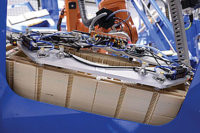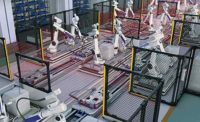Some plant managers and employees view safety requirements and safeguarding as overly burdensome and an impediment to efficient production. No doubt there are situations where guarding or barriers have been an obstacle. But it does not have to be that way.
In manufacturing applications that require guarding or barriers, the No. 1 goal is to properly protect people. However, the impact on required tasks and material flow into and out of work areas should also be considered. Barrier guards must be designed to accomplish both goals.
Too often we learn safety by accident. That is, we investigate incidents, determine their causes, and decide how to best improve the design and operations in the future.
The problem with this approach is it is one dimensional: focusing on either the hazard or the adverse outcome (injury, damage or other consequences). The typical recommendation for corrective action is limited to safety improvements; for example, removing or isolating the hazard or its potential to cause harm. This recommendation is then incorporated into design standards for new equipment, often without considering their consequences to overall operation.
For mechanical hazards, the design standards can include the addition of barrier guards. These are relatively inexpensive and passive, meaning they don’t have to be activated to provide protection.
Barrier guards are very effective in keeping people or other equipment from being exposed to mechanical hazards. Unfortunately, they can present unforeseen problems when installed without a full review of worker and equipment safety and efficiency.
Importance of Review Teams
New assembly equipment or assembly equipment undergoing major changes should be reviewed for safety and operations prior to startup. In addition, periodic reviews should be conducted of equipment for safety and efficient operation in the work site where the equipment is installed.
Separate teams should be established to review worker and equipment safety, and worker and equipment efficiency. The reviews should follow a planned agenda and include minutes. Team leaders must be capable of completing the analysis in a reasonable amount of time.
The team should consist of five or six members, including those who use and maintain the equipment, as well as those who work in the area where the equipment is located and operated. If possible, the team should also include those who designed the equipment and a representative of management.
Not everyone who participates in the analysis has to be a full member of the team. Some could join the team only during discussion of areas within their specialty. In either case, the review teams help establish and build employee involvement.
The Safety Review
During the safety review, barrier guards installed for new equipment or added to existing equipment should first be considered in light of how they protect people and equipment from hazards. The team needs to identify all possible hazards and related risks in a specific work area, and recommend control measures.
For example, equipment can sometimes expel broken parts, tooling or fixtures. The team needs to determine how well the guards can withstand the impact of such objects, or of a large moving piece, such as a robot arm.
The team also needs to create guidelines for workers so they do not take actions that undermine their safety. Workers should be encouraged to creatively determine how to best accomplish their individual tasks, but they should never view barrier guards as an obstacle to safety. This perception can lead to arbitrary removal of the guards, which can unintentionally undermine their and others’ safety.
Workers remove barrier guards for several reasons, usually to access equipment for troubleshooting or maintenance. Operational information and history must be analyzed to determine why and how often guarding is being removed and or rendered inoperative. If workers remove barrier guards regularly, the team might consider using another safeguarding approach so as to enhance worker safety.
If removal occurs occasionally, the team should recommend ways to limit this practice and increase the assurance that guards will be reinstalled. The use of interlocks is highly recommended. Another option is to secure the guards with fasteners that can only be removed or adjusted with a tool.
The team also needs to ensure worker safety while guards are missing. Two ways to make workers aware of this situation are painting the guard location or placing a warning sign there.
The Efficiency Review
This review focuses on how barrier guards impact material flow and ergonomics.
After documenting all material movement both into and out of a work area, the team must determine if operators use alternative means to move material because of barrier guards. If alternative means are used, the team can propose solutions or refer the issue to technical or design personnel to explore.
Regarding ergonomics, the team must determine if the barrier guards force operators or maintenance technicians to improperly position themselves while performing their tasks. If so, the team should provide ergonomic solutions that maintain or increase worker productivity.
Reports and Recommendations
“What gets documented, gets done” is a good rule to follow. After the teams complete their reviews and analysis, all findings and recommendations should be documented in separate reports. These reports should be kept on file and serve as a basis for the next scheduled reviews.
It is very important that each review team include a resolution of recommendations in its final report. This ensures that any changes to recommendations, or decisions not to implement a recommendation, are fully documented.
After the recommendations from each report are implemented, the results should be recorded in another document. Safety and efficiency reviews should not be considered finished until this follow-up document is received.
Reviews should be performed at least annually. However, a review is also recommended before equipment startup after one or more of the following events has occurred:
- modification or reconfiguration of the equipment or a process (including remanufacturing, rebuilding, overhaul and repair, reconditioning, refurbishing or restoring);
- relocation or redeployment of the equipment or process;
- a safety incident or near hit;
- equipment or tooling change or adjustment (such as dies, rolls, knives, etc.);
- any incident that could cause damage to the barrier guards (such as impact from expelled parts, or a collision with moving equipment).





